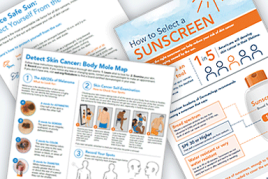7 travel skin care tips from dermatologists
You get to check out new places and activities when you travel, but if you’re not careful, you might bring home more than memories. It’s not unusual to come home from a trip with a new rash from the extra time in the sun, exposure to new environments, or changes to your skin care routine.
Reduce your risk and keep your skin healthy and looking good while traveling by packing the right products and taking precautions.

Whether you’ve planned the perfect getaway or take an impromptu trip, keep these dermatologist-approved tips in mind:
Cover your feet to stay fungus-free. It’s impossible to know whether the person ahead of you in the TSA line or who stayed in your room before you had a fungal infection. To avoid athlete’s foot and fungal nail infections while traveling, avoid walking around barefoot. Instead, wear:
Socks in the TSA line and in your hotel room.
Flip-flops or shower shoes in your hotel bathroom and pool area.
Protect your skin from the sun during outdoor activities and while traveling in a car or airplane. The sun’s harmful UV rays can still increase your risk of skin cancer and premature skin aging through windows. Practice safe sun while traveling by:
Seeking shade — including lowering airplane window shades.
Wearing sun-protective clothing, like the options at What to wear to protect your skin from the sun.
Applying a broad-spectrum, water-resistant sunscreen with an SPF of 30 or higher to all skin not covered by clothing.
Reapply your sunscreen every two hours, or after swimming or sweating.

Bring your own skin care products, especially if you have sensitive skin. Skin care products provided by hotels tend to have fragrance, which can be irritating. Your travel skin care routine should look like your at-home routine — this reduces your risk of having an allergic skin reaction to a product with unknown ingredients.
Moisturize your skin, as airplanes and different climates can make your skin drier. Apply moisturizer when your skin is still damp after bathing, and whenever it feels dry. If you have dry skin, apply petroleum jelly to help lock in moisture.
Avoid chafing and blisters if you walk a lot on your trip by applying petroleum jelly to areas where skin touches skin. Check out the advice at How to prevent and treat blisters before you leave for a museum, tour, or other walking-heavy activity.
Check for bedbugs as soon as you get to your hotel room or lodgings. These bugs could be hiding in the furniture, even in nice hotels. Follow the tips at Bedbugs: How to avoid bringing them home to check your room and luggage for these pests.
Prevent bug bites if your trip includes outdoor activities, like hiking. You might encounter bugs and insects you don’t usually see at home, or ones that spread diseases. Reduce your risk by taking the steps at Tips to prevent and treat bug bites.
Your travel skin care packing list
Dermatologists say to pack these travel skin care essentials before you take off:
A wide-brimmed hat
Sunglasses with UV protection
Long-sleeved shirts and pants appropriate for the climate you’re traveling to
SPF 30+ sunscreen that’s broad-spectrum and water-resistant
Moisturizer, cleanser, and other products from your usual routine in travel-size containers
Petroleum jelly
Shower or swim shoes
Socks for your hotel room
Bug spray
I came home with a rash — what should I do?
You’re not alone if you notice an allergic skin reaction, bug bite, or skin or nail infection after traveling. If you get a new rash during or after a trip, partner with a board-certified dermatologist to get relief.
Tell your dermatologist where you traveled and for how long; activities you did on your trip; and if anyone you traveled with has the same symptoms.
You can locate a board-certified dermatologist in your area at Find a dermatologist.
Images
Getty Images
References
Post-Travel Dermatologic Conditions. Centers for Disease Control and Prevention. Published April 23, 2025. Accessed May 9, 2025.
Written by:
Brooke Schleehauf
Reviewed by:
Raj Chovatiya, MD, PhD, MSCI, FAAD
Esteban Fernandez Faith, MD, FAAD
Carla Torres-Zegarra, MD, FAAD
Last updated: 11/24/25
 Atopic dermatitis: More FDA-approved treatments
Atopic dermatitis: More FDA-approved treatments
 Biosimilars: 14 FAQs
Biosimilars: 14 FAQs
 How to trim your nails
How to trim your nails
 Relieve uncontrollably itchy skin
Relieve uncontrollably itchy skin
 Fade dark spots
Fade dark spots
 Untreatable razor bumps or acne?
Untreatable razor bumps or acne?
 Tattoo removal
Tattoo removal
 Scar treatment
Scar treatment
 Free materials to help raise skin cancer awareness
Free materials to help raise skin cancer awareness
 Dermatologist-approved lesson plans, activities you can use
Dermatologist-approved lesson plans, activities you can use
 Find a Dermatologist
Find a Dermatologist
 What is a dermatologist?
What is a dermatologist?
